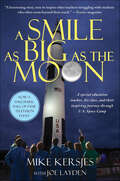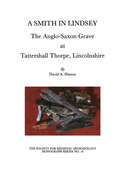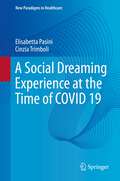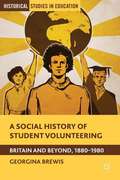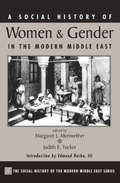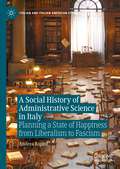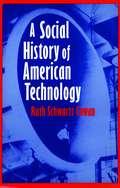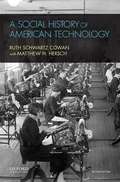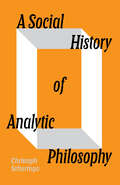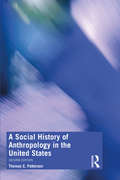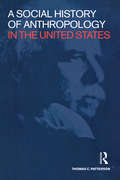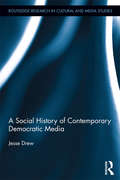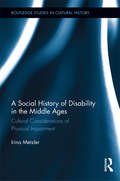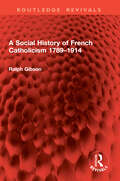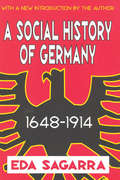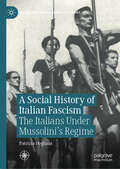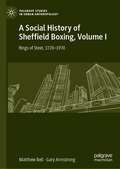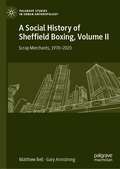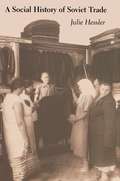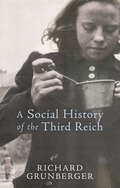- Table View
- List View
A Smart Girl's Guide to Manners: The Secrets to Grace, Confidence, and Being Your Best
by Nancy HolyokeWith this comprehensive manners guide, girls learn proper etiquette for everyday events and tricky social situations. The book is filled with great advice on everything from eating in fancy restaurants and handling troublemakers at parties to regaining composure after embarrassing accidents.
A Smarter Toronto: Some Reassembly Required
by Bob HankeThis book bridges media, technocultural, urban, and journalism studies to examine the role of journalism in relation to a smart city project on Toronto’s waterfront. From the announcement of the public-private partnership called Sidewalk Toronto to the project’s termination, a mediatized controversy unfolded. Through an assemblage approach to this project and a case study of The Globe and Mail and the Toronto Star, it follows the actors and chronicles the Quayside project story as a conversation about the promise and perils of a future “smart” neighbourhood. In the news of Waterfront Toronto, Sidewalk Labs, other actors, events, and developments, there were multiple voices and views, interpretations and arguments, that manifested conflicting interests and values. As a locally situated actor, journalism produced a porous discourse that expressed a proposeand- public pushback movement. This work of articulating mediation conditioned the project’s alteration and dissolution within asymmetrical relations of power. In addition to a wave of opposition that inflected the project’s enactment, a time lag between project time and governmental policymaking made the controversy over this future urban space intractable. With their residual symbolic power, quality journalism contributed to dialogical urban learning.
A Smile as Big as the Moon: A Special Education Teacher, His Class, and Their Inspiring Journey Through U.S. Space Camp
by Joe Layden Mike KersjesThe inspiring true story of how one special education teacher got his class to Space Camp—now a Hallmark Hall of Fame television event.“A heartening story, sure to inspire other teachers struggling with students who often seem beyond their reach.” —Teacher magazineMike Kersjes always believed that his students could do anything—even attend the prestigious Space Camp in Huntsville, Alabama, where some of America’s best and brightest high school students compete in a variety of activities similar to those experienced by NASA astronauts training for shuttle missions. The challenge was convincing everyone else that the kids in his special education class, with disabilities including Tourette’s syndrome, Down’s Syndrome, dyslexia, eating disorders, and a variety of emotional problems, would benefit from the experience and succeed. With remarkable persistence, Kersjes broke down one barrier after another, from his own principal’s office to the inner sanctum of NASA, until Space Camp finally opened its doors. After nine months of rigorous preparation, Kersjes’s class arrived at Space Camp, where they turned in a performance beyond everyone’s expectations.“A testament to how perseverance can get results and how children can perform surprising feats in a system that doesn’t always work to help children.” —Pittsburgh Post-Gazette“Kersjes’s refreshing, heart-warming account proves that faith and vision can yield great things.” —Publishers Weekly
A Smith in Lindsey: The Anglo-Saxon Grave at Tattershall Thorpe, Lincolnshire (The Society for Medieval Archaeology Monographs #16)
by David A. Hinton"Contents Include: An introduction to the grave, conservation, metallurgical and other analyses, a catalogue of organic and inorganic materials, and a discussion of dates and context."
A Social Critique of Corporate Reporting: A Semiotic Analysis of Corporate Financial and Environmental Reporting (Routledge Revivals)
by David CrowtherThis title was first published in 2002: This text is concerned with the role of corporate reporting in UK public limited companies. It is a common assumption that the most significant part of any corporate report is the accounting information contained within. This book, however, takes a different view. The central argument is that the purpose of corporate reporting has changed from one primarily of stewardship and accountability to shareholders to a more outward- and forward-looking perspective. The author argues that one of the driving forces for this change in orientation is the discourse of environmental accounting, along with other forces. The book is essentially explorative. The author is concerned with looking at different aspects of the changes in corporate reporting and taking different perspectives in the development of the argument.
A Social Dreaming Experience at the Time of COVID 19 (New Paradigms in Healthcare)
by Elisabetta Pasini Cinzia TrimboliThe book describes the experience of four Social Dreaming Matrices held online between March and May 2020, during the first lockdown caused by the Covid 19 emergency. The pandemic isolated us and imposed prolonged contact with ourselves and our solitary thoughts. Against this backdrop, there was hope for change, a desire for a different kind of sociability and different forms of intimacy. On the basis of this evidence, our research supports the shift "from experiencing trauma to reacting to trauma", looking at a collective traumatic experience not only as something to be overcome but as an opportunity for a transformation that changes our mental schemes in relation to the external context. We have identified Social Dreaming as a privileged technique to overcome a collective traumatic experience, supporting its elaboration through collective feelings, new connections between intuition and rational thought, the discovery of community meanings. The authors's thesis is that the much-needed transition from 'magical thinking' to 'transformative thinking' takes place in a setting that is able to contain the anxieties of life's transitional phases, supporting the creation of new rituals and new social bonds and sustaining the passage from “me” to a “wider we”.
A Social History Of Student Volunteering
by Georgina BrewisGeorgina Brewis takes a long view of the experience of going to university in Britain over a hundred year period. She explores students' extra-curricular volunteering, fundraising, campaigning and protest activities in Britain and beyond to show that voluntary action was central to the emergence of a distinct student movement. Brewis also considers the evolution of volunteering since the late nineteenth century through study of students' activities and argues that the universities made significant contributions to causes and campaigns ranging from educational reconstruction in 1920s Europe, relief for victims of fascism in the 1930s, and international development in the 1960s. The book draws on rich historical sources and a wider range of student testimony than any earlier study to tell the fascinating story of how ordinary women and men students engaged with the pressing social and international problems of the twentieth century.
A Social History Of Women And Gender In The Modern Middle East
by Margaret Lee Meriwether Judith TuckerIn this important new work, Margaret Meriwether and Judith Tucker synthesize and make accessible the results of the extensive research on women and gender done over the last twenty years. Using new theoretical approaches and methodologies as well as nontraditional sources, scholars studying women and gender issues in Middle Eastern societies have made great progress in shedding light on these complex subjects. A Social History of Women and Gender in the Modern Middle East provides an overview of this scholarship on women and gender in the nineteenth- and twentieth-century Middle East. The book is organized along thematic lines that reflect major focuses of research in this area--gender and work, gender and the state, gender and law, gender and religion, and feminist movements--and each chapter is written by a scholar who has done original research on the topic. Although structured around the individual author’s own work, the chapters also include overviews and assessments of other research, highlights of ongoing debates and key issues, and comparisons across regions of the Middle East. An insightful introduction centers the various chapters around key theoretical, methodological, and historical issues and makes connections with other areas of social historical research on the Middle East and with research on gender and women’s history in other parts of the world. Although there are many studies available on women and gender, A Social History of Women and Gender in the Modern Middle East provides a breadth of coverage and assessment of the field that is not found elsewhere.
A Social History of Administrative Science in Italy: Planning a State of Happiness from Liberalism to Fascism (Italian and Italian American Studies)
by Andrea RapiniThis book traces the origins, life and death of Administrative Science in Italy as an academic discipline between the nineteenth and twentieth centuries. It does so by combining the study of ideas, institutional history, intellectual history and social history. The Faculty of Law first introduced Administrative Science in 1875, with the aim of providing the elite with the necessary tools to distribute wealth more equally, to take care of the population and, thus, to make the young Italian State more legitimate in the eyes of the emerging masses. Law and social sciences were merged with the aim of increasing reforms, including that of creating a State of Happiness for all citizens. Throughout its 70-year existence, Administrative Science was deprived of its contents and scientific independence, and academically overshadowed by Administrative and Public law. Finally, although the liberal elites discarded the reformer project of Administrative Science even before Fascism turned everything upside down, most of the original traits of this knowledge were absorbed into Fascist corporate and totalitarian structures.
A Social History of American Technology
by Ruth Schwartz Cowan(back of book) For over 250 years American technology has been regarded as a unique hallmark of American culture and an important factor in American prosperity. Despite this, American history has rarely been told from the perspective of the history of technology. A Social History of American Technology fills this gap by surveying the history of American technology from the tools used by the earliest native inhabitants to the technological systems- cars and computers, aircraft and antibiotics- we are familiar with today. Cowan makes use of the most recent scholarship to explain how the unique characteristics of American cultures and American geography have affected the technologies that have been invented, manufactured, and used throughout the years. She also focuses on the key individuals and ideas that have shaped important technological developments. The text explains how various technologies have affected the ways in which Americans work, govern, cook, transport, communicate, maintain their health, and reproduce. Cowan demonstrates that technological change has always been closely related to social development, and explores the multiple, complex relationships that have existed between such diverse social agents as households and businesses, the scientific community and the defense establishment, artists and inventors. Divided into three sections- colonial America. industrialization, the 20th century- A Social History of American Technology is ideal for courses in American social and economic history, as a correlated text for the American history survey, as well as for courses that focus on the history of technology. It offers students the unique opportunity to learn not only how profoundly technological change has affected the American way of life, but how profoundly the American way of life has affected technology.
A Social History of American Technology (Second Edition)
by Ruth Schwartz Cowan Matthew H. HerschA Social History of American Technology, Second Edition, tells the story of American technology from the tools used by its earliest inhabitants to the technological systems - cars and computers, aircraft and antibiotics - that we are familiar with today. Ruth Schwartz Cowan and Matthew H. Hersch demonstrate how technological change has always been closely related to social and economic development, and examine the important mutual relationships between social history and technological change. They explain how the unique characteristics of American cultures and American geography haveaffected the technologies that have been invented, manufactured, and used throughout the years - and also the reverse: how those technologies have affected the daily lives, the unique cultures, and the environments of all Americans.
A Social History of Analytic Philosophy
by Christoph SchuringaHow a supposedly apolitical form of philosophy owes its continuing power to social and political forcesAnalytic philosophy is the leading form of philosophy in the English-speaking world. What explains its continued success? Christoph Schuringa argues that its enduring power can only be understood by examining its social history. Analytic philosophy tends to think of itself as concerned with eternal questions, transcending the changing scenes of history. It thinks of itself as apolitical. This book, however, convincingly shows that the opposite is true.The origins of analytic philosophy are in a set of distinct movements, shaped by high-ly specific sets of political and social forces. Only after the Second World War were these disparate, often dynamic movements joined together to make &‘analytic philosophy&’ as we know it. In the climate of McCarthyism, analytic philosophy was robbed of political force.To this day, analytic philosophy is the ideology of the status quo. It may seem arcane and largely removed from the real world, but it is a crucial component in upholding liberalism, through its central role in elite educational institutions. As Schuringa concludes, the apparently increasing friendliness of analytic philosophers to rival approaches in philosophy should be understood as a form of colonization; thanks to its hegemonic status, it reformats all it touches in service of its own imperatives, going so far as to colonize decolonial efforts in the discipline.
A Social History of Anthropology in the United States
by Thomas C. PattersonThis book offers a comprehensive introduction to the social history of anthropology in the United States, examining the circumstances that gave rise to the discipline and illuminating the role of anthropology in the modern world. Thomas C. Patterson considers the shifting social and political-economic conditions in which anthropological knowledge has been produced and deployed, the appearance of practices focused on particular regions or groups, the place of anthropology in structures of power, and the role of the educator in forging, perpetuating, and changing representations of past and contemporary peoples. The book addresses the negative reputation that anthropology took on as an offspring of imperialism, and provides fascinating insight into the social history of America. In this second edition, the material has been revised and updated, including a new chapter that covers anthropological theory and practice during the turmoil created by multiple ongoing crises at the beginning of the twenty-first century. This is valuable reading for students and scholars interested in the origins, development, and theory of anthropology.
A Social History of Anthropology in the United States: Second Edition
by Thomas C. PattersonIn part due to the recent Yanomami controversy, which has rocked anthropology to its very core, there is renewed interest in the discipline's history and intellectual roots, especially amongst anthropologists themselves. The cutting edge of anthropological research today is a product of earlier questions and answers, previous ambitions, preoccupations and adventures, stretching back one hundred years or more. This book is the first comprehensive history of American anthropology. Crucially, Patterson relates the development of anthropology in the United States to wider historical currents in society. American anthropologists over the years have worked through shifting social and economic conditions, changes in institutional organization, developing class structures, world politics, and conflicts both at home and abroad. How has anthropology been linked to colonial, commercial and territorial expansion in the States? How have the changing forms of race, power, ethnic identity and politics shaped the questions anthropologists ask, both past and present? Anthropology as a discipline has always developed in a close relationship with other social sciences, but this relationship has rarely been scrutinized. This book details and explains the complex interplay of forces and conditions that have made anthropology in America what it is today. Furthermore, it explores how anthropologists themselves have contributed and propagated powerful images and ideas about the different cultures and societies that make up our world. This book will be essential reading for anyone interested in understanding the roots and reasons behind American anthropology at the turn of the twenty-first century. Intellectual historians, social scientists, and anyone intrigued by the growth and development of institutional politics and practices should read this book.
A Social History of Contemporary Democratic Media (Routledge Research in Cultural and Media Studies)
by Jesse DrewThe last few decades have helped dispel the myth that media should remain driven by high-end professionals and market share. This book puts forward the concept of "communications from below" in contrast to the "globalization from above" that characterizes many new developments in international organization and media practices. By examining the social and technological roots that influence current media evolution, Drew allows readers to understand not only the Youtubes and Facebooks of today, but to anticipate the trajectory of the technologies to come. Beginning with a look at the inherent weaknesses of the U.S. broadcasting model of mass media, Drew outlines the early 1960s and 1970s experiments in grassroots media, where artists and activists began to re-engineer electronic technologies to target local communities and underserved audiences. From these local projects emerged national and international communications projects, creating production models, social networks and citizen expectations that would challenge traditional means of electronic media and cultural production. Drew’s perspective puts the social and cultural use of the user at the center, not the particular media form. Thus the structure of the book focuses on the local, the national, and the global desire for communications, regardless of the means.
A Social History of Disability in the Middle Ages: Cultural Considerations of Physical Impairment (Routledge Studies in Cultural History #14)
by Irina MetzlerWhat was it like to be disabled in the Middle Ages? How did people become disabled? Did welfare support exist? This book discusses social and cultural factors affecting the lives of medieval crippled, deaf, mute and blind people, those nowadays collectively called "disabled." Although the word did not exist then, many of the experiences disabled people might have today can already be traced back to medieval social institutions and cultural attitudes. This volume informs our knowledge of the topic by investigating the impact medieval laws had on the social position of disabled people, and conversely, how people might become disabled through judicial actions; ideas of work and how work could both cause disability through industrial accidents but also provide continued ability to earn a living through occupational support networks; the disabling effects of old age and associated physical deteriorations; and the changing nature of attitudes towards welfare provision for the disabled and the ambivalent role of medieval institutions and charity in the support and care of disabled people.
A Social History of English Rugby Union
by Tony CollinsFrom the myth of William Webb Ellis to the glory of the 2003 World Cup win, this book explores the social history of rugby union in England. Ever since Tom Brown’s Schooldays the sport has seen itself as the guardian of traditional English middle-class values. In this fascinating new history, leading rugby historian Tony Collins demonstrates how these values have shaped the English game, from the public schools to mass spectator sport, from strict amateurism to global professionalism. Based on unprecedented access to the official archives of the Rugby Football Union, and drawing on an impressive array of sources from club minutes to personal memoirs and contemporary literature, the book explores in vivid detail the key events, personalities and players that have made English rugby. From an era of rapid growth at the end of the nineteenth century, through the terrible losses suffered during the First World War and the subsequent ‘rush to rugby’ in the public and grammar schools, and into the periods of disorientation and commercialisation in the 1960s through to the present day, the story of English rugby union is also the story of the making of modern England. Like all the very best writers on sport, Tony Collins uses sport as a prism through which to better understand both culture and society. A ground-breaking work of both social history and sport history, A Social History of English Rugby Union tells a fascinating story of sporting endeavour, masculine identity, imperial ideology, social consciousness and the nature of Englishness.
A Social History of France, 1789–1914
by Peter McpheeThis volume provides a lively and authoritative synthesis of recent work on the social history of France and is now thoroughly updated to cover the 'long nineteenth century' from 1789-1914. Peter McPhee offers both a readable narrative and a distinctive, coherent argument about this remarkable century and explores key themes such as: - peasant interaction with the environment - the changing experience of work and leisure - the nature of crime and protest - changing demographic patterns and family structures - the religious practices of workers and peasants - the ideology and internal repercussions of colonisation. At the core of this social history is the exercise and experience of 'social relations of power' - not only because in these years there were four periods of protracted upheaval, but also because the history of the workplace, of relations between women and men, adults and children, is all about human interaction. Stimulating and enjoyable to read, this indispensable introduction to nineteenth-century France will help readers to make sense of the often bewildering story of these years, while giving them a better understanding of what it meant to be an inhabitant of France during that turbulent time.
A Social History of French Catholicism 1789–1914 (Routledge Revivals)
by Ralph GibsonFirst published in 1989, A Social History of French Catholicism 1789–1914 is a clear survey of over a hundred years of Catholicism in French society. It chronicles the religious experience of French men and women, both clergy and laity, in post-revolutionary France. The book begins with a look at Catholic life in the Old Regime and during the French Revolution, and proceeds to topical chapters on the secular clergy, the religious orders, popular religion, religious practice by region, gender and age, and the social classes. The final chapter deals with the re-Christianization of France in the latter part of the nineteenth century. This volume will be of interest to students and researchers of history and religion.
A Social History of Germany, 1648-1914
by Eda SagarraThis volume is a pioneering effort to examine the social, demographic, and economic changes that befell the Jewish communities of Central Europe after the dissolution of the Habsburg Empire. It consists of studies researched and written especially for this volume by historians, sociologists, and economists, all specialists in modern Central European Jewish affairs. The era of national rivalry, economic crises, and political confusion between the two World Wars has been preceded by a pre-World War I epoch of Jewish emancipation and assimilation. During that period, Jewish minorities had been harbored from violent anti-Semitism by the Empire, and they became torchbearers of industrialization and modernization. This common destiny encouraged certain common characteristics in the three major components of the Empire, Austria, Hungary, and the Czech territories, despite the very different origins of the well over one million Jews in those three lands. The disintegration of the Habsburg Empire created three small, economically marginal national states, inimical to each other and at liberty to create their own policies toward Jews in accord with the preferences of their respective ruling classes. Active and openly discriminatory anti-Semitic measures resulted in Austria and Hungary. The only liberal heir country of the Empire was Czechoslovakia, although simmering anti-Semitism and below surface discrimination were widespread in Slovakia. While one might have expected Jewish communities to return to their pre-World War I tendencies to go their independent ways after the introduction of these policies, social and economic patterns which had evolved in the Habsburg era persisted until the Anschluss in Austria, German occupation in Czechoslovakia, and World War II in Hungary. Studies in this volume attest to continuing similarities among the three Jewish communities, testifying to the depth of the Empire's long lasting impact on the behavior of Jews in Central Euro
A Social History of Italian Fascism: The Italians Under Mussolini’s Regime (Italian and Italian American Studies)
by Patrizia DoglianiThis book uncovers how fascism reshaped Italian society according to its ideological and historical interpretation of the Italian nation and people and identifies the strengths of this transformation, but also the resistance encountered from, for example, women and minority groups, to accept it in everyday life. It analyzes the success achieved by some policies aimed at popular masses in order to integrate them into the nation, and how fascism initiated an early welfare state project to address specific categories of society such as veterans, families, mothers and children. The book also questions the concept and practices of social citizenship reserved only for those who gave evidence of formal adherence to fascism.
A Social History of Sheffield Boxing, Volume I: Rings of Steel, 1720–1970 (Palgrave Studies in Urban Anthropology)
by Gary Armstrong Matthew BellA Social History of Sheffield Boxing combines urban ethnography and anthropology, sociological theory and place and life histories to explore the global phenomenon of boxing. Raising many issues pertinent to the social sciences, such as contestations around state regulation of violence, commerce and broadcasting, pedagogy and elite sport and how sport is delivered and narrated to the masses, the book studies the history of boxing in Sheffield and the sport’s impact on the cultural, political and economic development of the city since the 18th century. Interweaving urban anthropology with sports studies and historical research the text expertly examines a variety of published sources, ranging from academic papers to biographies and from newspaper reports to case studies and contemporary interviews. In Volume I, Bell and Armstrong construct a vivid history of boxing and probe its cultural acceptance in the late 1800s, examining how its rise was inextricably intertwined with the industrial and social development of Sheffield. Although Sheffield was not a national player in prize-fighting’s early days, throughout the mid-1800s, many parochial scores and wagers were settled by the use of fists. By the end of the century, boxing with gloves had become the norm, and Sheffield had a valid claim to be the chief provincial focus of this new passion—largely due to the exploits of George Corfield, Sheffield’s first boxer of national repute. Corfield’s deeds were later surpassed by three British champions: Gus Platts, Johnny Cuthbert and Henry Hall. Concluding with the dual themes of the decline of boxing in Sheffield and the city's changing social profile from the 1950s onwards, the volume ends with a meditation on the arrival of new migrants to the city and the processes that aided or frustrated their integration into UK life and sport.
A Social History of Sheffield Boxing, Volume II: Scrap Merchants, 1970-2020 (Palgrave Studies in Urban Anthropology)
by Gary Armstrong Matthew BellA Social History of Sheffield Boxing combines urban ethnography and anthropology, sociological theory and place and life histories to explore the global phenomenon of boxing. Raising many issues pertinent to the social sciences, such as contestations around state regulation of violence, commerce and broadcasting, pedagogy and elite sport and how sport is delivered and narrated to the masses, the book studies the history of boxing in Sheffield and the sport’s impact on the cultural, political and economic development of the city since the 18th century. Interweaving urban anthropology with sports studies and historical research the text expertly examines a variety of published sources, ranging from academic papers to biographies and from newspaper reports to case studies and contemporary interviews. In Volume II, Bell and Armstrong examine the revival of Sheffield boxing after the decline of the 1950s and 1960s outlined in Volume I. Instigated by two men from outside the city—Brendan Ingle and Herol Graham—this renaissance became known as the ‘Ingle style,’ which between 1995 and 2014 produced four world champions: Naseem Hamed, Johnny Nelson, Junior Witter and Kell Brook. These successes inspired others and raised Sheffield’s profile as a boxing city, which in the 1990s and 2000s produced two more world champions in Paul ‘Silky’ Jones and Clinton Woods. In this second volume, Bell and Armstrong track the resurgence of boxing to the present day and consider how the game and its players have changed over time.
A Social History of Soviet Trade: Trade Policy, Retail Practices, and Consumption, 1917-1953
by Julie HesslerIn this sweeping study, Julie Hessler traces the invention and evolution of socialist trade, the progressive constriction of private trade, and the development of consumer habits from the 1917 revolution to Stalin's death in 1953. The book places trade and consumption in the context of debilitating economic crises. Although Soviet leaders, and above all, Stalin, identified socialism with the modernization of retailing and the elimination of most private transactions, these goals conflicted with the economic dynamics that produced shortages and with the government's bureaucratic, repressive, and socially discriminatory political culture.A Social History of Soviet Trade explores the relationship of trade--official and unofficial--to the cyclical pattern of crisis and normalization that resulted from these tensions. It also provides a singularly detailed look at private shops during the years of the New Economic Policy, and at the remnants of private trade, mostly concentrated at the outdoor bazaars, in subsequent years. Drawing on newly opened archives in Moscow and several provinces, this richly documented work offers a new perspective on the social, economic, and political history of the formative decades of the USSR.
A Social History of The Third Reich
by Richard GrunbergerOne of the most devastating portraits ever drawn of a human society - life in Hitler's Germany during the Third ReichThe Nazis developed a social system unprecedented in history. It was rigidly hierarchical, with the seemingly beneficent and ascetic figure of Hitler at the top - focus for the homage and aspirations of every man,woman and child. How did the 'ordinary citizen' live under such a system? The author discusses such subjects as beauty in the Third Reich (no cosmetics, no slimming) as well as charting how you progressed to the elite Nazi cadres - administrators, propagandists or coercers. It shows childhood with the Hitler Youth and describes the intense medieval ritual injected into every phase of life from school and university to farm labour. It shows life in the office, in industry, in the professions - doctors, lawyers, artists - and in the Nazi Party itself. Finally, it documents what happened at the two extremes of German society - to the aristocrats and to the Jews.


